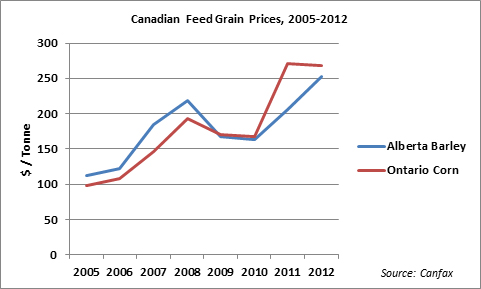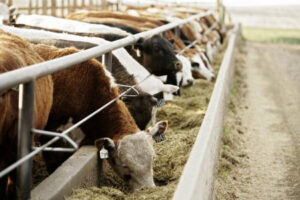Explaining Growth Promotants Used in Feedlot Cattle
Feed efficiency in cattle can make or break profitability in the feeding sector, and has environmental implications. The costs of buying a calf and the feed needed to finish it are the two largest variable expenses facing the beef cattle feeding sector. Feed costs are higher than ever because of poor growing conditions in major grain producing countries, because of the use of feed grains in ethanol production, and because of increasing competition of land for crop production versus urban development.

Growth promotants are among the many sophisticated tools used by feedlots and other producers to raise more beef, more rapidly, using less feed, while maintaining high standards of animal health, carcass quality and food safety. Growth promotants include ionophores, growth implants, and beta-agonists. A number of products within each category are approved for use by Health Canada’s Veterinary Drug Directorate.
Types of growth promotants
Antimicrobials: Ionophores
Ionophores are antimicrobials delivered through cattle feed that improve nutrient availability to the animal. They can improve feed efficiency and weight gain, reduce methane production, reduce the incidence of bloat and acidosis, and prevent diseases like coccidiosis.
Ionophores improve feed efficiency by acting on the rumen microbes. Most rumen microbes convert the complex fiber and starch in forage and grain into simple molecules that can be absorbed into the bloodstream to provide energy and protein to the animal. Some rumen bacteria (known as methanogens) convert the dietary fiber and starch into methane gas. Methane contains energy, but it cannot be absorbed by the animal, so it is belched out and wasted. Ionophores improve feed efficiency and weight gain by selectively inhibiting methanogenic bacteria, and allow the beneficial rumen bacteria to make more feed energy available to the animal.
Antimicrobial: a substance that can destroy or prevent the growth of microorganisms. There are many different types of antimicrobial substances, including antibiotics, antiprotozoals, alcohol, soap and bleach.
Antibiotic: an antimicrobial substance produced by a microorganism (or a synthetic version) that can kill or prevent the growth of another microorganism. In human and veterinary medicine, antibiotics are used to treat bacterial infections.
Hormonal growth implants
Other growth promotants impact how nutrients are used by the animal after the nutrients have been absorbed into the bloodstream. Growth implants, delivered through a pellet under the skin in the animal’s ear, enhance the reproductive hormones that occur naturally in the animal. In steers, implants replace some of the hormones that were removed when the animal was castrated.
Implants generally encourage protein deposition and discourage fat deposition. This improves both weight gain and feed conversion. Fat deposition requires more than twice as much feed energy as protein deposition does. In addition to this, muscle tissue contains around 70% water, while fat contains less than 25% water. This means that for every ten pounds of muscle gained, about three pounds comes from dry feed and seven pounds comes from water. This ratio is reversed for fat growth (roughly seven pounds from dry feed and three pounds from water). Aggressive implant regimes may negatively impact carcass quality (maturity, marbling score, tenderness, and possibly lean color), especially if used on the wrong types of cattle.
Beta adrenergic agonists
Beta adrenergic agonists (e.g. ractopamine and zilpaterol) are the newest class of growth promotants, commercially available since 2004. These feed additives are not antimicrobials, and do not mimic or supplement reproductive hormones. Asthma medications are also beta-agonists.
‘Beta adrenergic agonist’ is a complicated name that describes what these products do. ‘Adrenergic’ means ‘resembling adrenaline’. ‘Agonist’ (the opposite of antagonist) means that ‘it works in a similar manner’. The ‘beta’ refers to the particular receptor that it binds to on the muscle cell surface. So a beta adrenergic agonist is a substance that binds to a beta receptor on the muscle, and acts sort of like adrenalin. Adrenalin diverts blood flow from the digestive organs towards the muscle during the ‘fight or flight’ response. Similarly, beta-agonists re-directs nutrients so that more growth occurs in muscle tissue than in internal organs.
All beta-agonists approved for beef cattle increase protein deposition (muscle growth), growth rate, feed efficiency, and carcass leanness. Some beta-agonists also reduce protein turnover (reduce muscle breakdown), resulting in increased dressing percentage. Beta-agonists are fed at the end of the feeding period, when muscle growth is slowing, fat deposition is speeding up, and feed efficiency is dropping off.
As with aggressive implants, beta-agonists must be managed appropriately, on the right class of cattle in order to avoid negative consequences on carcass quality. The benefit of feeding beta-agonists can be lost if the product is fed for too long, or if the delay between product withdrawal and slaughter is too long.
Benefits of growth promotants

Growth promotants are valuable tools for the cattle feeding sector. In a study published in the Journal of Animal Science, Dr. Ira Mandell of the University of Guelph, Robert Berthiaume of the Agriculture and Agri-Food Canada (AAFC) Lennoxville Research Station, and Carole Lafrenière of the AAFC Kapuskasing station reported that overall average daily gain was 21% higher and feed efficiency was 23% better for grain finished cattle given both implants and ionophores compared to control cattle. Economists John Lawrence and Maro Ibarburu at Iowa State University reported that feedlot average daily gain increased when ionophores (3% increase), implants (16%), and beta-agonists (16%) were used. Feed efficiency improved when ionophores (4% better), implants (10%) and beta-agonists (14%) were used. Their analysis indicated that feedlot production costs would be 10% higher if producers chose not to or were unable to use implants, ionophores or beta agonists.
Canfax data indicate that between 1977 and 2007, Canada slaughtered 20% fewer cattle but produced 11% more beef. When fed cattle exports are included in this calculation, Canada produced 10% more cattle, but produced 39% more beef.
Impact on food safety and human health
Like vaccines and other veterinary products, all growth promotants approved for use in Canada have been reviewed for human and animal safety and approved by Health Canada’s Veterinary Drug Directorate. Label and veterinary directions indicate proper administration doses and routes, as well as pre-slaughter withdrawal times that ensure that the product has been metablized by the animal before it is slaughtered. All animals and carcasses are subjected to pre- and post-slaughter inspections to look for signs of ill health. Random samples of carcass tissues and organs are tested for residues from antimicrobials, growth promotants, and other contaminants.
Ionophores
Ionophores are often erroneously included in discussions about the concern of antimicrobial use in livestock and the potential link to antimicrobial resistance in humans. Ionophores are not used in human medicine, and have a very different mode of action than other antibiotics. This leads to the conclusion that ionophores do not lead to cross-resistance to antibiotics of importance in human medicine. As a result, reducing or eliminating ionophore use would have detrimental impacts on cattle production with no benefit for human health.
When advocate groups spread statistics like “over 80 percent of all antibiotics used in the United States are used in food animals, and the vast majority of this use is for animals that are not sick”, they not only ignore the much higher populations and body weights of livestock compared to Americans, they include ionophores in the calculation.
Hormones
Growth promotant safety has been reviewed by many experts and agencies, including Health Canada, the World Health Organization and the Food and Agriculture Organization of the United Nations. All have concluded that hormones can be used safely in beef production. The levels found in food products, such as beef, are too low to be of risk to human health.
To put these levels into perspective, consider the levels of estrogens that occur naturally in all plants and animals, including humans. This table shows that a person would have to eat 3 million hamburgers every day from cattle administered growth hormones before he or she would be exposed to as much estrogen as an average woman produces daily.
| Quantity | Source | Nanograms of estrogen |
|---|---|---|
| 75 g | Beef from steer given hormones | 2 |
| 355 ml | Beer | 15 |
| 75 g | Raw peas | 500 |
| 75 g | Raw cabbage | 2976 |
| 1 pill | Birth control | 35,000 |
| Per day | Adult male | 100,000 |
| Per day | Adult woman | 5,000,000 |
| Per day | Pregnant woman | 90,000,000 |
Testosterone-containing implants are similar; there is a safety factor of several thousand-fold based on the assumption that people consume the equivalent of 6 to 7 servings of beef per day.
Beta-agonists
Concerns about the use of beta-agonists (e.g. ractopamine and zilpaterol) in livestock are popular in the media. Some importing nations have a zero tolerance policy for certain kinds of beta-agonists, which make their use an issue in some trade negotiations.
In fact, a person would have to eat more than 180 servings of beef per day, or 30 servings of liver per day, from cattle administered beta-agonists in order to get the effect of one “hit” of asthma medication.
Environmental impacts

A 2012 study published in the Journal of Animal Science quantified how growth promotant technologies in North America (including ionophores, implants and beta-agonists) allow cattlemen to produce the same amount of beef from fewer cattle in less time, has led to environmental benefits. If we were to remove these technologies from our production system, we would need 10% more cattle, 10% more land, and 10% more feed to produce the same amount of beef. Doing this would also require 7% more fuel and fertilizer. The reduced feed efficiency and longer days to finish would also mean that the cattle would produce 10% more manure and greenhouse gas in the process.
The adoption of these technologies have allowed North American beef producers to continue to provide consumers with a safe, high quality product in the face of rising feed and land prices while reducing environmental implications. As with all refined technology, appropriate and optimal use of growth promotants in feedlot cattle can improve animal performance and value, while improper use result in no benefit, reduced carcass value, and/or lost money. Feedlots, nutritionists and veterinary experts base their decisions to use these products on past experience, the type of cattle being fed, marketing practices and packer specifications.
Learn more:
- The Environmental Hoofprint of Canada’s Beef Industry (BCRC article)
- Video: Use of Implants and Carcass Quality (YouTube presentation by Dr. Sandi Parr, feedlot nutritional and production consultant)
- Videos: Three-part series on antimicrobial resistance (BeefResearch.ca and RealAgriculture.com)
- How Feed Efficiency Affects the Profitability and Environmental Impact of Feedlot Cattle (Ontario Ministry of Agriculture, Food and Rural Affairs)
- The environmental and economic impact of removing growth-enhancing technologies from US beef production (Journal of Animal Science 90:3527-3537)
- Growth Implants for Beef Cattle (Manitoba Agriculture and Resource Development)
- Use of beta agonists as a growth promoting feed additive for finishing beef cattle (UW Extension Wisconsin Beef Information Center fact sheet)
- Optimizing Feedlot Feed Efficiency (BCRC webpage)
- Antimicrobial Resistance (BCRC webpage)
Click here to subscribe and receive email notifications when new content is posted on the BCRC Blog.
The sharing or reprinting of BCRC Blog articles is welcome and encouraged. Please provide acknowledgement to the Beef Cattle Research Council and list the website address, www.BeefResearch.ca.
We welcome your questions, comments and suggestions. Contact us directly at info@beefresearch.ca or generate public discussion by posting your thoughts below.
Stay connected by following us on Twitter @BeefResearch, liking us on Facebook, and subscribing to our YouTube Channel.